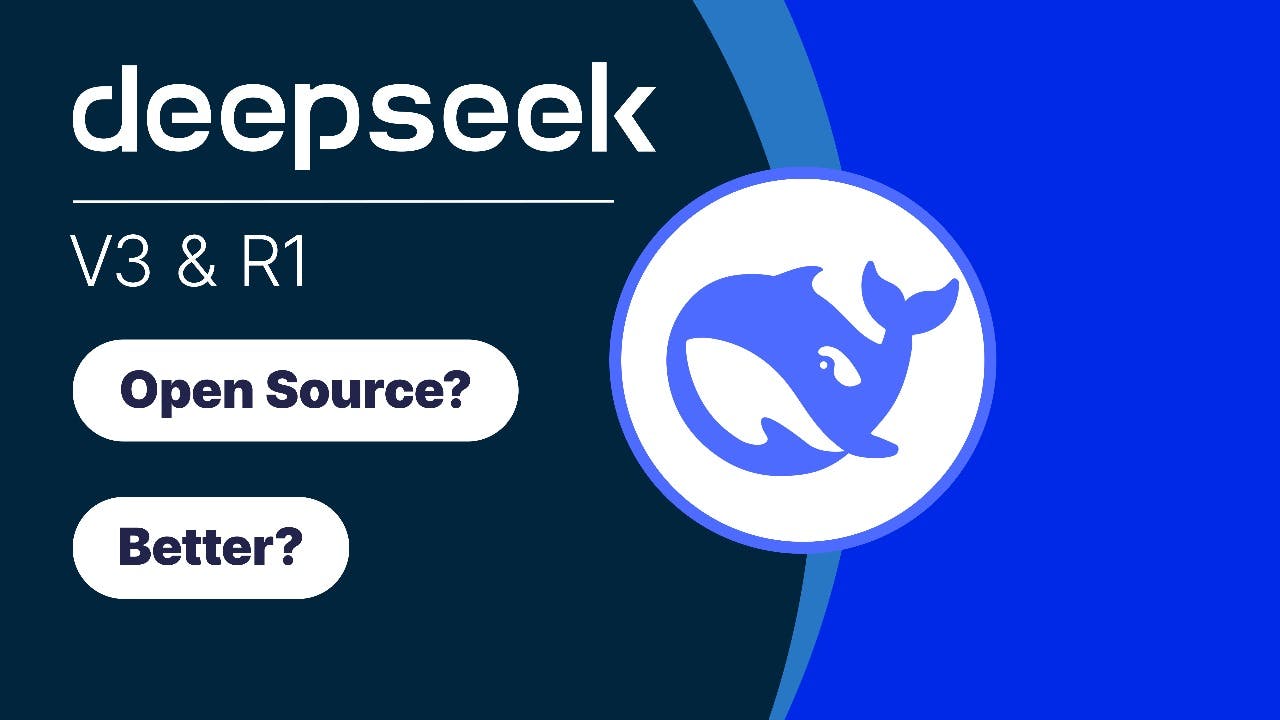The Rise of DeepSeek AI
Artificial Intelligence has rapidly evolved, with models like GPT, LLaMA, and Claude pushing the boundaries of what machines can achieve. Among the latest advancements, DeepSeek has emerged as a powerful force, introducing innovative methods for AI training, architecture, and accessibility. While DeepSeek, as a company, continues to evolve, this article will specifically focus on two of its models: DeepSeek-V3, which is fully open-source, and DeepSeek-R1, which retains an open-source license but has undisclosed implementation details. Designed to enhance productivity and creativity, DeepSeek’s AI models are reshaping how we understand and interact with artificial intelligence.
What Makes The DeepSeek Models Unique?

The DeepSeek models, V3 and R1, set themselves apart from conventional AI models with their open-source methodologies, streamlined architecture, and specific training procedures. Here’s what makes them different:
- Advanced Training Process:
Unlike many AI models that rely heavily on supervised learning, DeepSeek leverages reinforcement learning techniques, allowing it to improve decision-making dynamically based on feedback. Additionally, it is trained on a wide range of data, ensuring a more comprehensive and adaptable learning process across various domains.
- Optimized Architecture:
DeepSeek presents an enhanced neural architecture that reduces latency and increases processing efficiency. This ensures faster response times while using fewer computational resources, making it highly scalable.
- Robust Data Integration:
By utilizing both structured and unstructured data, DeepSeek enhances contextual awareness and deep reasoning capabilities, making its outputs more insightful and accurate.
- Open-Source Innovation:
One of DeepSeek’s greatest strengths is its commitment to open-source development. This fosters collaboration among researchers, developers, and AI enthusiasts while promoting transparency and accessibility in AI advancements. However, it’s worth mentioning that future models, like DeepSeek-R1, might not remain open-source, as the company may take a different direction with upcoming releases.
How DeepSeek Models Impact the AI Landscape
DeepSeek’s models, particularly DeepSeek-V3 and DeepSeek-R1, are reshaping the AI landscape by driving innovation, increasing competition, and making AI more accessible to developers. These models represent a significant shift from traditional proprietary AI systems, offering open-source alternatives that foster experimentation and customization. By doing so, DeepSeek is advancing the state of AI research and enabling a broader range of users to leverage powerful AI capabilities.
- An Expansive AI Future:
One of the most notable impacts of DeepSeek’s models is their role in promoting an expansive AI future. The AI industry has long been dominated by proprietary models, where licensing fees, API limitations, and closed development environments restrict access. DeepSeek, particularly with DeepSeek-V3, disrupts this trend by embracing an open-source framework. This approach allows researchers, developers, and businesses to modify and adapt the model to their specific needs, leading to greater experimentation and innovation. By making high-quality AI tools available without the usual restrictions, DeepSeek fosters a more diverse and competitive AI ecosystem where advancements are not limited to a handful of major tech companies.
- Competitive Edge in AI Development:
DeepSeek also provides a competitive edge in AI development by setting new standards for both AI research and real-world applications. Training and deploying AI models can be costly and resource-intensive, but DeepSeek’s advancements have improved the efficiency of model training and inference. By optimizing performance and reducing computational demands, DeepSeek enables developers to create AI-powered applications that are faster, more reliable, and cost-effective. This efficiency also makes AI more accessible to organizations with limited resources, allowing them to compete with industry leaders without requiring massive infrastructure investments.
- Better Accessibility for Developers:
Unlike closed-source AI models that restrict access through controlled APIs, DeepSeek-V3 allows developers to directly integrate and modify the model for a wide range of applications. This flexibility encourages innovation, as developers are free to experiment with new use cases, optimize the model for their specific needs, and contribute back to the community. However, while DeepSeek-R1 is also open-source, its undisclosed implementation details may pose some challenges for developers who require full transparency and control over the model’s inner workings. This limitation implies that while R1 is available for use, it may not offer the same level of flexibility as V3 for certain advanced applications.
By providing open-source alternatives to proprietary AI, DeepSeek is reshaping the AI landscape, empowering a broader community to drive innovation. With better accessibility, efficiency, and customization, DeepSeek's models set the stage for a more inclusive and competitive AI ecosystem.
Advantages Over Existing AI Models

The DeepSeek models outperform traditional AI models in several aspects:
- Efficiency Gains:
DeepSeek delivers high performance with lower computational costs, making it more efficient than traditional models. It reduces resource consumption while maintaining speed and accuracy, making it ideal for real-time applications.
- Transparency and Customization:
Unlike black-box models, DeepSeek offers greater transparency, allowing developers to understand and modify its inner workings. This makes it highly customizable for different industries and specific use cases.
- Expansive Knowledge Base:
Trained on a larger dataset, DeepSeek has strong contextual awareness and reasoning skills. This allows it to handle complex queries, generate more accurate responses, and stay updated on evolving trends.
The Evolution of DeepSeek: A Timeline
- Early Research & Development (2023-2024):
Addressing inefficiencies in current AI models was the first goal of the fundamental research that led to DeepSeek.
- Initial Model Release (2024):
After their release to the public, DeepSeek-V3 and R1 gained recognition for their open-source nature and distinctive training approaches.
- Major Enhancements (2024-2025):
Important changes were made to the models, increasing their effectiveness, broadening their knowledge base, and honing their interaction features.
- Present and Future (2025 & Beyond):
With constant contributions from the international AI community, DeepSeek keeps improving and becoming more relevant.
The Significance of Open-Source AI
DeepSeek’s open-source framework provides several key advantages, making it a powerful tool for AI development.
- Community-Driven Growth:
One of its most significant benefits is community-driven growth. Since the model is open to researchers and developers worldwide, it evolves rapidly through collective contributions. Experts from various fields continuously refine the model, introducing new techniques, optimizing performance, and addressing shortcomings. This collaborative approach ensures that DeepSeek remains at the forefront of AI advancements, benefiting from a diverse range of insights and innovations that a single company might not achieve alone.
- Wider Accessibility:
Another major advantage is wider accessibility, which helps democratize AI technology. Unlike proprietary models that often require expensive licenses or subscriptions, DeepSeek’s open-source nature removes financial barriers, allowing individuals, startups, and organizations—regardless of their budget—to integrate advanced AI into their projects. This inclusivity fosters a level playing field, enabling innovation even in regions or industries where access to AI has traditionally been limited. By making cutting-edge technology available to a broader audience, DeepSeek supports the development of new applications that might not have been possible under restrictive, commercial AI models.
- Enhanced Security & Transparency:
Enhanced security and transparency set DeepSeek apart from closed-source AI systems. Proprietary models operate as black boxes, making it difficult to assess their decision-making processes or detect vulnerabilities. In contrast, open-source frameworks allow researchers and developers to thoroughly examine the model’s architecture, training data, and security protocols. This transparency enables the community to identify and fix potential biases, ethical concerns, or security risks more efficiently than a single company’s internal team could. Additionally, organizations using DeepSeek can customize the model to meet their specific security and regulatory requirements, ensuring greater trust and reliability in sensitive applications such as healthcare, finance, or government services.
By adopting an open approach, DeepSeek accelerates innovation, enhances inclusivity, and bolsters security and trust, making it an attractive option for leveraging AI without proprietary constraints.
Ideal Use Cases for DeepSeek AI
The DeepSeek models, V3 and R1, excel in various domains, including:
- Natural Language Processing (NLP):
Ideal for chatbots, virtual assistants, and automated content generation.
- Scientific Research:
Assisting in data analysis, knowledge synthesis, and hypothesis generation.
- Software Development:
Enhancing code generation, debugging, and automation processes.
- Education & Training:
Providing personalized tutoring and adaptive learning experiences.
Conclusion: The Future of DeepSeek AI
DeepSeek's focus on effectiveness, accessibility, and innovation is poised to revolutionize the AI sector. With DeepSeek-V3 being open-source, it will evolve collaboratively, increasing transparency and inclusivity in AI. However, it's worth noting that future models may not maintain this open-source approach, as the company’s direction could change. Nevertheless, as these models continue to evolve, they have the potential to revolutionize artificial intelligence, making them effective tools for researchers, developers, and companies alike.

